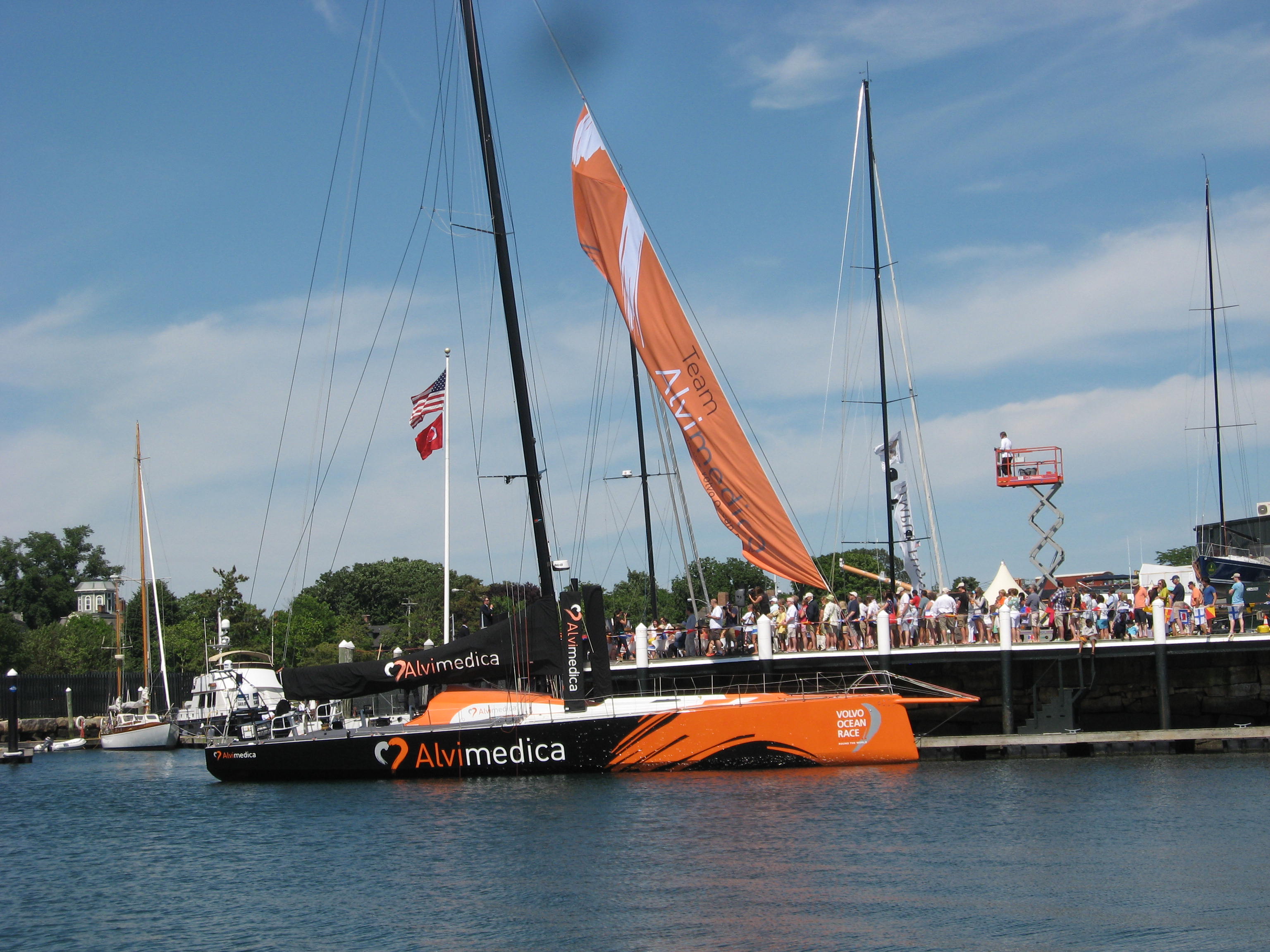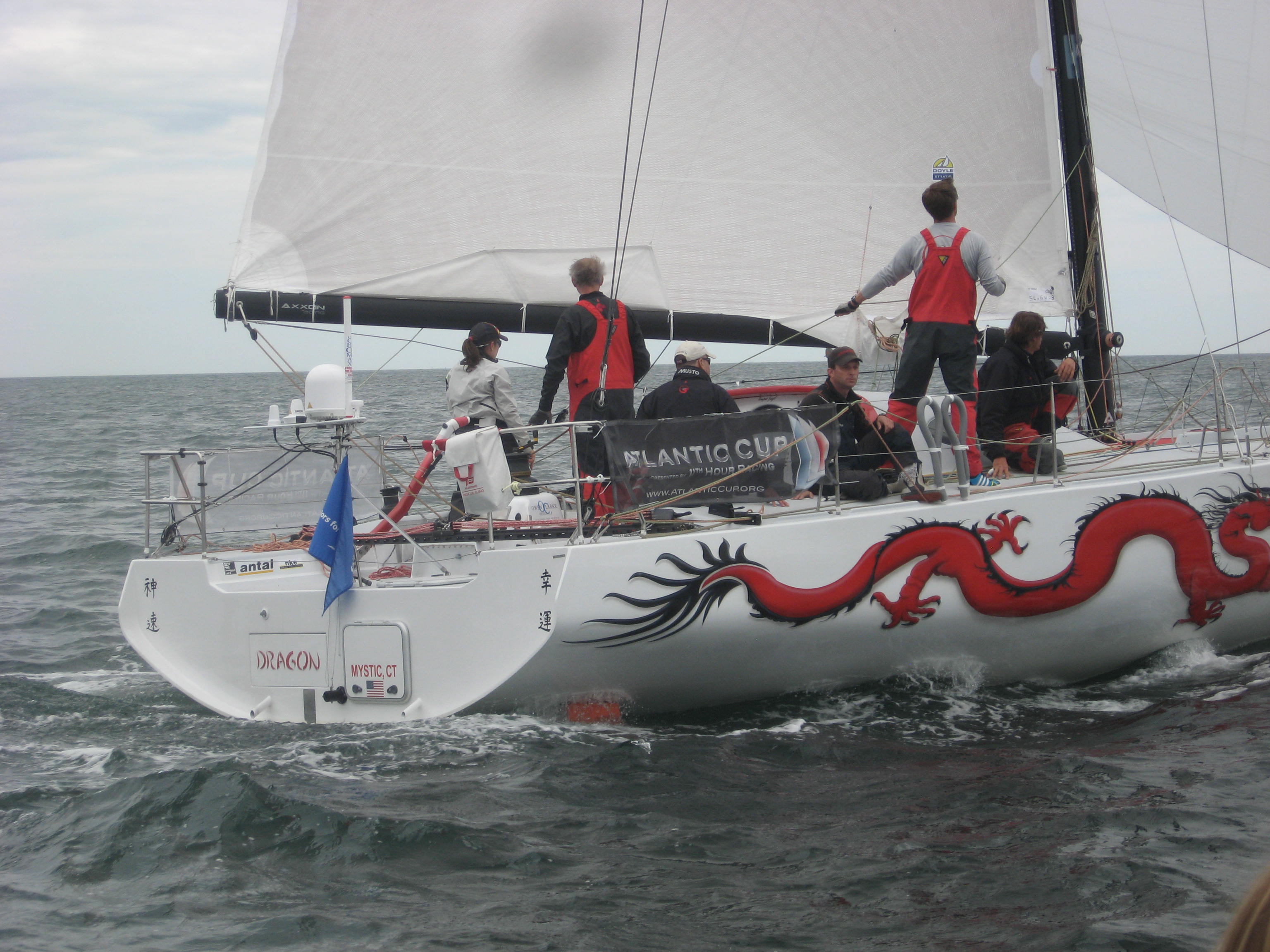What are the THREE most important things to consider when contemplating a voyage?
Planning, Preparation, regardless of your Experience.
The kind of sailing contemplated by the sailors described in the second half of this post can go nowhere without using all three legs of the seamanship stool: Planning, Preparation and Experience.
In Newport a couple of weeks ago I counted the following classes of boats:
Team Alvimedica, US ENTRY IN THE VOR who were out Friday, doing the Around the Island Race as part of the NYYC annual regatta.

US entry in the 2014/15 Volvo Ocean Race during their Naming Ceremony
There were various High Test boats, like the TP 542 Interlodge, Bella Mente, Rambler and others in town for the Bermuda Race.

The TP 52 Interlodge out practicing on Narragansett Bay prior to the NYYC Annual regatta
Daily half a dozen Etchells arrive in advance of their worlds.
There was a record turn out for the NYYC annual regatta (Regatta Number 160)
There were two different Around Jamestown Island speed records broken, one on the Mastrand 32 Cat and one in the large mono hull category (Bella Mente in fact)….Phew…
A few of the Class 40’s in town for The Atlantic Cup are on moorings or in the Shipyard patiently waiting for the Bermuda race.

Dragon, one of half a dozen Class 40’s in town for the Atlantic Cup seen here competing in the second to last race of the inshore series.
Another C40, Bodacious Dream, was coming in from a Circumnavigation.
Then there was the Clagett Memorial Clinic and Regatta, (one of the key regattas for sailors not as physically capable as many of us)
There were kids arriving for a few days of coaching in the Booke Gonzales clinic for up and coming winners.
Oh, and the usual beer can, Shields, J-24 & sport boat racing on Monday, Tuesday, Wednesday, Thursday nights and just so much more. In lots of sailing ports one can get lots of boats, but in my experience that are all of a similar species at any given time. Only in Newport can one get such a wide swath of sailing boats for different uses all at the same time. AND frankly this is kind of a slow year with only 3 world championships this year….Where else do you get that?
OK, NOW reference my second sentence, above:
ALL of the boats ands sailors in attendance for anyone of these events have the first two characteristics in common, regardless of the level of their third.
Sitting quietly in the midst of all this sailing energy there is one boat making hardly a ruffle where she is moored at the west end of the docks at the Newport Shipyard. This boat is the absolute epitome of preparation and planning
The boat in question is a 40-meter LOA (131 feet) trimaran.

Rarely do American sailors get close to the elite of the French ocean racing scene, unless of course that travel to France. This boat came to us and is seen here at the Newport Shipyard. Spindrift Racing are waiting for a “weather window” of suitable characteristics to give them a shot at breaking the all time and absolute Trans-Atlantic sailing speed record west to east, from Ambrose light to The Lizard in SW England
I speak of course of Spindrift Racing, the former Banque Populaire under whose colors she set the current absolute Transat-Atlantic speed record from Ambrose to the Lizard in 3 days 15 hours and change, including a 24-hour run record of 905 miles, which is averaging a small dollop of spray south of 33 knots. Moored as she is away from the cluster of huge (tall) spars with which the bulk of the 40 meter cruising yachts at the shipyard are rigged there is, to the practiced eye, an incongruity to her spar as seen from out on the lower bay. It is thick, as in like a wing mast yet not so tall. The wing section is not so long, perhaps a meter and a bit fore and aft. The entire spar has been modified for this record. The Spindrift team cut some large number of feet, I want to say 20 feet off the top and re-did the sails since, as Banque Populaire the last time, her crew sailed almost all the way with a reef in I am told.
The current owners and crew are of course waiting for that much discussed and worried over piece of equipment “essential” to setting and/or breaking Trans-Atlantic sailing records today, the “Weather Window”. According to the chap I was chatting with on Wednesday, said window is still a minimum 10 days out, so the crew was flying home to France (where else?). It is hard to absorb the scope of this boat from pictures but I try.
Standing next to Spindrift Racing, one’s mind is readily boggled by just how massive this boat is.

When simply looking at a picture of Spindrift it is not possible to gauge the scope or the scale of this boat.
For starters the lashings for the cap shrouds are 25 mmm spectra based on being roughly half the diameter of my water bottle.

Compare the size of my water bottle, roughly 2.0 inches wide and 9 inches tall with the lashings for the side stays.
One can commonly can stand on the dock and get a good idea of the on-deck workings of a boat. NOT so with this one whose working area/cockpit is perhaps 10 feet up on the air. This, “flight deck” one is tempted to call it, has all the sail controls and is contained inside a hemisphere the arc of which is outlined by the mainsheet traveler. The outboard ends of the traveler are fixed to the aft cross beam about half way between the side of the main hull to the inside edge of the Ama (the name of the outside hulls on a Tri) on each cross beam. The traveler describes an arc around the stern and lands on the corresponding point on the opposite cross beam. I asked one of the crew about the loads on the mainsheet when the boat was fully loaded….About 15 tonnes he remarked.

A glimpse onto the flight deck
The bulk of this working area is trampoline netting. There are two wheels of not particularly large diameter connected by, and operating through, large motorcycle chain, roughly from a 1000 cc Super bike I’d reckon.

Spindrift giving a good impression of a slumbering Giant or Sea Monster, just waiting to be unleashed
Inside this platform live both the crew waiting on benches under the spray cowlings. OF the 13 crew members to be sailing aboard, three do not stand watches leaving two watches of 5 hands apiece. On the Flight Deck there are, well as the primary winches with their grinder pedestals, sailing instruments, misc. winches, control lines and the steering wheels and a p air of large suitcase shaped heavy material canvas bags. Their purpose I was told is to stow the tails of the various lines. The mainsheet is EIGHT to ONE and one end of it probably goes to a long hydraulic piston in the boom, unless they have removed it in the chase to make the boat lighter for this record attempt. The traveler is atop the radius at the back of the work platform and so the traveler adjusts the angle to the wind and the mainsheet adjusts the twist.

This image may give an idea of the size of things on this boat. These are merely the traveler blocks and my starboard paw for reference.
On Wednesday I took some pictures from the causeway adjacent to the Shipyard, the best place to actually see “down” onto the boat albeit giving up 50 yards of proximity.
There were a few guys working on the boat and I captured this picture of one of the guys standing on the dock next to her. You have to really look for him, which is remarkable because he is a stand out dressed in team uniform black and is standing on a largely light colored dock. For another reference, the white boat on the other side of the dock is a 75 foot cruising boat

It took me a few minutes to find the image with the crew member standing on the dock, so small is he relative to the boat. The white boat is 75 feet LOA.
Alongside the reduction in the mast height & weight (and the sail track and sail weight) in other weight savings, Tim Carrie, the only non-French part of the team and in charge of the considerable logistics support this caper requires, rattled off a long list of things they have done:
Taken the engine out, one dagger board The one on the starboard side) removed and the hole plugged up, shortening the port one and reducing it’s weight by 40% plus the reduction in mast height and a few other modifications which escaped me.
Reflect if you will on sailing this boat. To average 33 knots, one is sailing at or over 40 knots basically all the time. Next time you are bored grab a mate with a pick up truck, rig up some safety lines or similar mechanism in the back and have yer mate drive down an empty road on Sunday morning, at say 45-50 miles per hour with you hanging on while standing on the truck bed. To really get the effect, do it when in the midst of a downpour
Then do it for 3 days, with only 13 mates.

If you WERE to be steering Spindrift at 40 knots, this is where you would be standing. The B&G meters are about 80 feet away
What are the two things that these guys are doing that ANY sailor can do, regardless of their own EXPERIENCE, the passage to be undertaken or the boat aboard which they will undertake it?
PLANNING
AND
PREPARATION.
It is absolutely just not possible to take on an exercise of this magnitude without planning of the highest order and the finest mesh. The good news is there is nothing special about planning and preparation for going sailing it just needs to be done.















